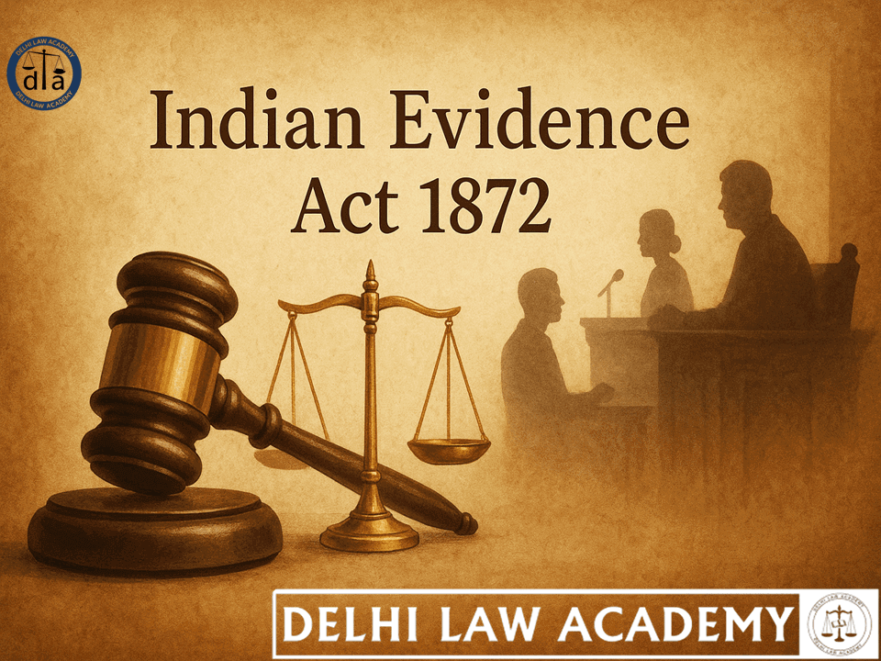
⚖️ Difference Between Admission and Confession
Key Questions
- What is the difference between an admission and a confession?
- Which confessions are not admissible?
- Can a confessional FIR be used against the informant-accused?
- Whether the oath administered by a custom officer to state the truth can vitiate the confession?
We now proceed to find answers to these questions from landmark judgments of the Supreme Court and Privy Council.
Evidence Act Explained – Part 8
The Evidence Act forms the bedrock of any and every Judicial Service exam in the country. Its thorough knowledge is a must for all aspirants of RJS, DJS, PCS (J) and every other Judicial Service exam. To help such aspirants, Delhi Law Academy Jaipur has launched a series of study material modules on all important aspects of this vital part of their syllabus.
📖 Sections 24 – 27 of the Evidence Act
A Note on sections 24 – 27 of the Evidence Act [Confessions: admissibility and inadmissibility] supported by landmark Supreme Court and Privy Council Judgments.
Question 1: Whether the oath administered by a custom officer to state the truth can vitiate the confession?
Answer:
- A person summoned by an officer of customs under Section 108 of the Customs Act is under compulsion of law to state the truth. This compulsion, even if it amounts to a threat, emanates from law and not from a person in authority under Section 24.
- Therefore, the confession if made is not vitiated.
[Authority: Supreme Court in Veera Ibrahim v. State of Maharashtra (1976)]
🚔 Confessions Made to a Police Officer
- No confession made to a police officer shall be proved against a person accused of any offence.
🚔 Confessions While in Custody of Police
- No confession made by any person whilst in custody of a police officer shall be proved against him, unless it is made in the immediate presence of a Magistrate.
Question 2: Can a confessional FIR be used against the informant-accused?
Answer:
- If the FIR is given by the accused himself, the fact of giving the information is admissible as evidence of conduct under Section 8 of the Evidence Act.
- If it is a non-confessional statement, it is admissible against the accused as an admission under Section 21.
- But a confessional FIR to a police officer cannot be used against the accused due to Section 25.
[Authority: Supreme Court in Aghnoo Nagesia v. State of Bihar (1966)]
🔍 Information Received from Accused (Section 27)
When a fact is discovered in consequence of information received from an accused person in custody, that part of the information which relates distinctly to the fact discovered may be proved. Section 27 partially lifts the ban imposed by Sections 25 and 26.
Question 3: Which confessions are not admissible?
Answer:
- Confessions made under circumstances specified under Section 24 and before persons specified in Sections 25 and 26 are not admissible, except under circumstances in Section 27.
Rationale: The ban was presumably inspired by the fear that a person under Police influence might be induced to confess under undue pressure.
[Authority: Pulukuri Kottaya v. Emperor, Privy Council]
Question 4: What is the difference between an admission and a confession?
Answer 1:
- An admission made by an accused is admissible under Section 21, unless it amounts to a confession made under improper inducement, to a police officer, or while in custody. If it is a confession, admissibility depends on these factors.
- A statement admissible as admission may not be admissible as a confession.
- From the point of view of Section 30, a statement is admissible against co-accused only if it is a confession.
[Authority: Monir’s Law of Evidence]
Answer 2:
- Only voluntary and direct acknowledgement of guilt is a confession.
- If it falls short of actual admission of guilt, it may still be used as an admission under Section 21.
[Authority: Supreme Court in CBI v. V. C. Shukla (1998)]
📚 Continue Your Evidence Act Preparation
Don’t stop here! Strengthen your knowledge of the Evidence Act with our other fully solved tests:
📘 Free Study Material for Judiciary Aspirants!
Download our FREE study material prepared by Delhi Law Academy’s expert faculty.
❓ Frequently Asked Questions on Admissions & Confessions (Evidence Act)
A confession is a direct acknowledgment of guilt and is governed by Sections 24–30. Confessions face stricter admissibility rules, especially if made under inducement, to police officers, or in custody.
The only exception is when they are made in the immediate presence of a Magistrate.
But a confessional FIR given to a police officer cannot be used against the accused due to the bar in Section 25 of the Evidence Act.
- Made under inducement, threat, or promise (Section 24)
- Made to a police officer (Section 25)
- Made while in police custody, unless in presence of Magistrate (Section 26)
However, Section 27 allows discovery of facts to be proved from accused’s statements.
They test: admissibility, rationale behind inadmissibility, exceptions, and landmark case laws such as:
- Veera Ibrahim v. State of Maharashtra (1976)
- Aghnoo Nagesia v. State of Bihar (1966)
- Pulukuri Kottaya v. Emperor (Privy Council)
- An admission is generally admissible against its maker under Section 21.
- A confession faces stricter admissibility filters and may not be admitted if made under prohibited circumstances.
- Confessions can be used against co-accused (Section 30), while admissions cannot.
Thus, it directly affects the scope of evidence available in trials.
Contact us
📍 Delhi Law Academy – Jaipur Branch
6C, Tower 2, Coaching Hub, Pratap Nagar, Jaipur – 302033
📞 Phone:
+91 9911916552
+91 8447285606
✉️ Email:
contactus@delhilawacademy.com

